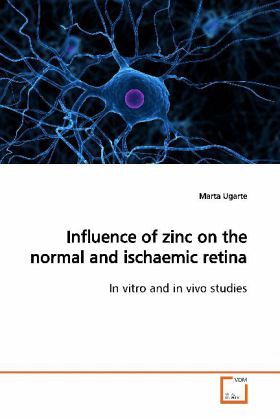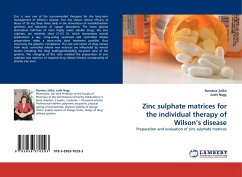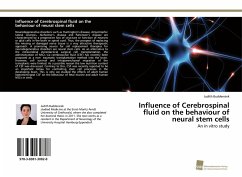
Influence of zinc on the normal and ischaemic retina
In vitro and in vivo studies
Versandkostenfrei!
Versandfertig in 6-10 Tagen
45,99 €
inkl. MwSt.

PAYBACK Punkte
23 °P sammeln!
In the mammalian retina, endogenous chelatable zincwas shown to be localised mainly in thephotoreceptors and retinal pigment epithelium. Zinclocalisation in the photoreceptors varied in lightand dark. Low (100 micromolar) levels of zincsulphate (ZnSO4) counteracted glutamate- andNMDA-induced lactate dehydrogenase release in ratcortical cultures; as well as the changes inGamma-aminobutyric acid (GABA)-immunoreactivitymediated by experimental ischaemia and NMDA inisolated rabbit retinas. However, high (500micromolar) levels of ZnSO4 caused lactatedehydrogenase release and alterations inGABA-immu...
In the mammalian retina, endogenous chelatable zinc
was shown to be localised mainly in the
photoreceptors and retinal pigment epithelium. Zinc
localisation in the photoreceptors varied in light
and dark. Low (100 micromolar) levels of zinc
sulphate (ZnSO4) counteracted glutamate- and
NMDA-induced lactate dehydrogenase release in rat
cortical cultures; as well as the changes in
Gamma-aminobutyric acid (GABA)-immunoreactivity
mediated by experimental ischaemia and NMDA in
isolated rabbit retinas. However, high (500
micromolar) levels of ZnSO4 caused lactate
dehydrogenase release and alterations in
GABA-immunoreactivity, and exacerbated the effects of
NMDA or ischaemia to the retina. When very low (1
micromolar) concentrations of ZnSO4 were present
during ischaemia, GABA-immunoreactivity was localised
to Müller cells, indicating that zinc prevents the
metabolism of GABA in Müller cells in the ischaemic
retina. High (500 micromolar) concentrations of ZnSO4
potentiated reactive oxygen species formation while
ameliorating lipid peroxidation. When low (1 nanomol)
levels of ZnSO4 were injected into the vitreous
humour of the rabbit eye the retina remained unaffected.
was shown to be localised mainly in the
photoreceptors and retinal pigment epithelium. Zinc
localisation in the photoreceptors varied in light
and dark. Low (100 micromolar) levels of zinc
sulphate (ZnSO4) counteracted glutamate- and
NMDA-induced lactate dehydrogenase release in rat
cortical cultures; as well as the changes in
Gamma-aminobutyric acid (GABA)-immunoreactivity
mediated by experimental ischaemia and NMDA in
isolated rabbit retinas. However, high (500
micromolar) levels of ZnSO4 caused lactate
dehydrogenase release and alterations in
GABA-immunoreactivity, and exacerbated the effects of
NMDA or ischaemia to the retina. When very low (1
micromolar) concentrations of ZnSO4 were present
during ischaemia, GABA-immunoreactivity was localised
to Müller cells, indicating that zinc prevents the
metabolism of GABA in Müller cells in the ischaemic
retina. High (500 micromolar) concentrations of ZnSO4
potentiated reactive oxygen species formation while
ameliorating lipid peroxidation. When low (1 nanomol)
levels of ZnSO4 were injected into the vitreous
humour of the rabbit eye the retina remained unaffected.












